Entries in landowner wind turbine (6)
12/31/09 Cash for Wind Leases: OR "I'll give you this big nickel for that little dime"
 Golden Opportunity or Another Green Cheese Sandwich?
Golden Opportunity or Another Green Cheese Sandwich?
Some say the success of the wind industry relies on empty cupboards in rural communities.
Struggling rural families who have signed on with wind developers now have a new industry to contend with, one that will pay out a lump sum in exchange for ownership of the wind lease and all that goes with it.
It reminds us of the many 'Check-into-Cash' or 'Payday Loans' stores that appear in blighted communities.
This quote is from an organization called "Wind Farm Capital" CLICK HERE to read at source
"Get an Upfront Lump Sum Cash Payment by Selling Wind Farm Lease"
"Financial Benefits of Selling Your Wind Farm Lease to Wind Farm Capital"
"In today’s economic climate, consumers and businesses alike are feeling the impact of the credit market squeeze, and finding it virtually impossible to secure capital, regardless of their credit history.
But Wind Farm Capital can provide a quick, easy, and welcome alternative by converting your wind farm lease royalties payment into a lump sum cash payment.
We provide the cash up front; there are no loan applications to fill out, no interest payments to budget for, and best of all, no default scenarios to worry about - no matter what happens to the lease down the road. Even if your lease terminates for some reason, you owe us nothing.
With multiple years’ worth of lease payments in your hands now, your options suddenly become endless. Whether you choose to pay down your existing debt, plan for your future, or invest in the market, the reward for each is similar - a windfall that leads to greater financial freedom, security, and long-term wealth."
NOTE FROM THE BPWI RESEARCH NERD: Please consult a lawyer before you sell your wind lease to anyone.
"By 2020, Xcel Energy [formerly Florida Power and Light] plans to more than double wind capacity system-wide from 2,800 megawatts to 7,000 megawatts.
Engelking said Xcel will buy or develop 3,000 megawatts of that power for its system in Minnesota or Wisconsin. She said the utility will focus on developing wind because tax benefits reduce energy costs to consumers."
NOTE FROM THE BPWI RESEARCH NERD: Wisconsin has just over 300 industrial scale turbines at present.
This proposal from Xcel for 3,000 megawatts of wind power requires the installation of at least two thousand 1.5MW turbines. Each turbine is close to 40 stories tall.
Xcel is not the only developer planning projects in our state. In order to meet the Governor's Task Force on Global warming recommendations, at least 14,000 more turbines need to be sited.
AND THE TURBINES JUST KEEP GETTING BIGGER
A new wind farm planned for the Town of Glenmore in Brown County calls for turbines 500 feet tall, or as tall as a 50 story building. This will make them the tallest structures in the state of Wisconsin.
WHO WILL OWN THE BROWN COUNTY WIND FARM?
WHO IS 'EMERGING ENERGIES OF WISCONSIN?'
"The CH Energy Group, owner of the New York utility Central Hudson Gas & Electric Corporation, holds a controlling interest in the project via its unregulated subsidiary Central Hudson Enterprises."
12/28/09 UPDATE on yesterday's turbine collapse: Another One Bites the Dust: What made turbine # 18 collapse?
Click on image below to watch an updated news report on the turbine collapse at the Fenner wind farm.
Turbine collapse draws concern from other proposed project areas
FENNER, N.Y. (WKTV) - Local residents are wondering if one wind turbine could collapse in Madison County, then it is very possible for a turbine to fall anywhere.
Fairfield resident Jim Salamone thinks why couldn't it happen in his back yard.
Salamone, who is opposed to the proposed wind turbine projects in Fairfield says he was not surprised when he woke up to find out a wind turbine had collapsed in Fenner. He says the meteorological tower that used to be right across from his home already collapsed because of wind and ice.
Meteorological towers are used to measure wind in areas where developers want to put turbines. Salamone says the meteorological tower that collapsed near his home was the third one to do so in as many years.
Salamone says he wonders if those towers can collapse so easily, and if a tall turbine can also collapse how safe is his property living so close to a proposed site.
"They must be 1250 feet from your house, 500 feet from the road. So if a 476 foot wind turbine comes down 500 feet from the road that is only going to leave you, what 24 feet (that) if the blade breaks that is has to travel before it could go through your car." said Salamone.
Salamone says he is not opposed to a wind turbine project if they are put in the right place, but he says the rolling hills near most homes in Fairfield, is not the right location for large turbines.
TURBINE FALLS AT FENNER WIND FARM
WSYR-TV [Click here to read at source and watch news clip]
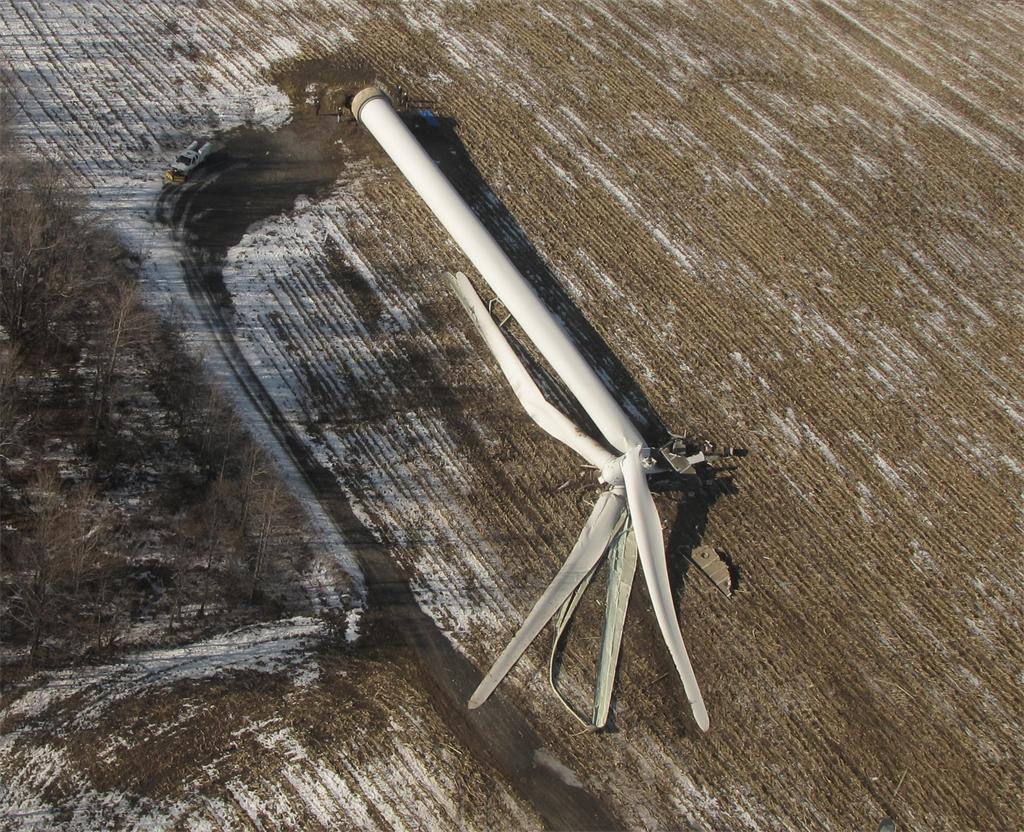
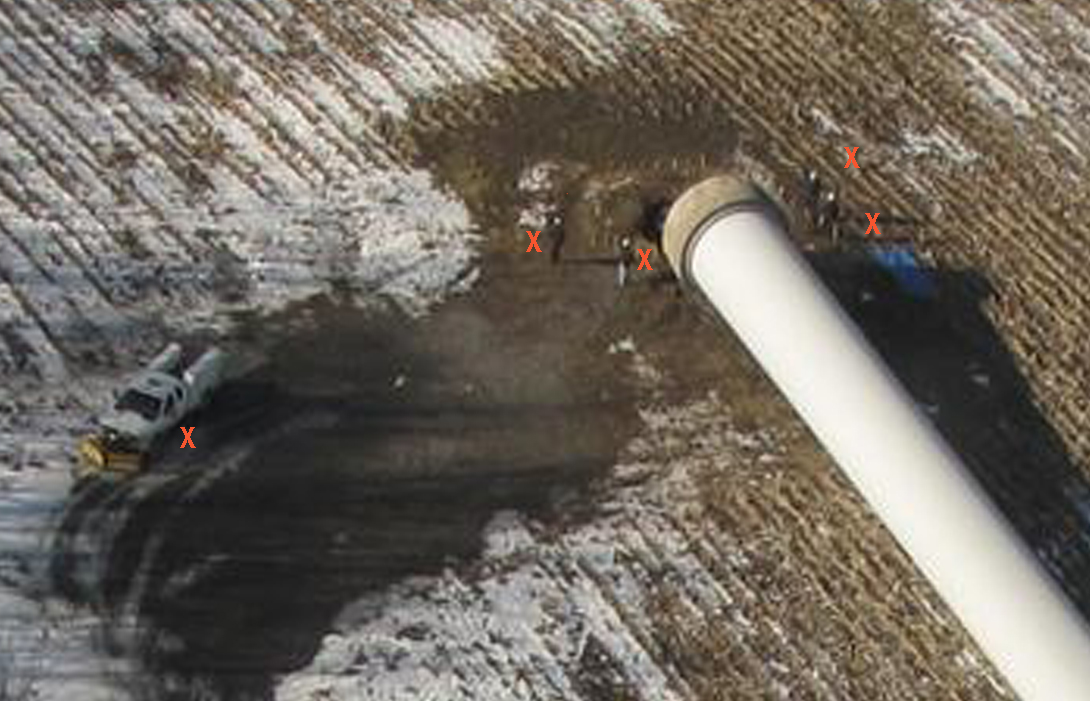
Fenner, Madison County (WSYR-TV) – A turbine at the Fenner wind farm has toppled, and engineers are on the scene trying to figure out how it happened.
The tower, which is more than 300 feet long from the base to the tip of the blade, is located just off Buyea Road, and is one of 20 generating electricity.
"I was turning over in bed and it sounded like a big clap of thunder" said Jill Van Allen, who lives across the street. "I was waiting to see the lightning through my bedroom window (but didn't)".
Fenner Town Supervisor Russ Cary was notified by company officials at Enel North America, which owns the farm. He tells us Enel did not have any answers as to how it happened, but adds, the towers were built a distance away from homes for this very reason-that if they collapse, they won't do any harm.
From another news story:
Officials investigating why 187 ton windmill collapsed in Fenner
QUOTE: "Bob Stinson, a resident of South Road nearly two miles from Turbine 18, said it sounded like "a sonic boom" when the windmill toppled.
"I felt it. It shook the house. It woke me up," Stinson said."
READ ENTIRE STORY BY CLICKING HERE
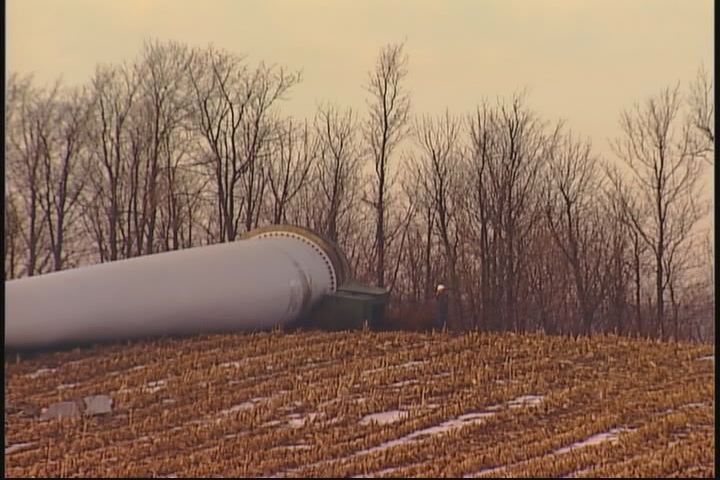
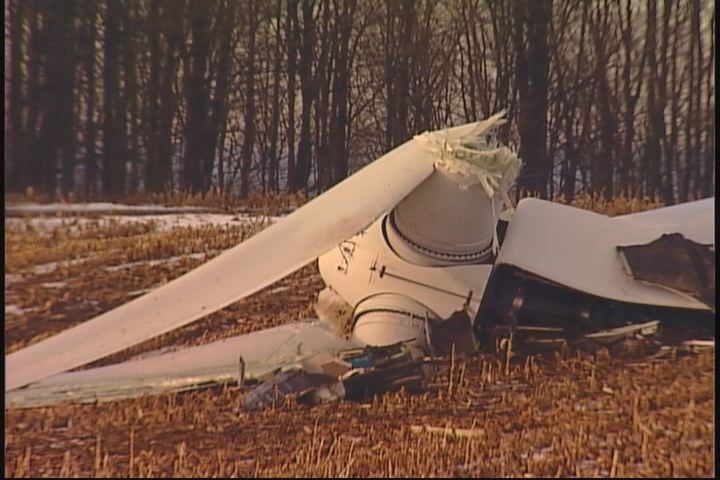
12/27/09 What is the effect of a wind farm on property values? A tale of two studies and a story problem
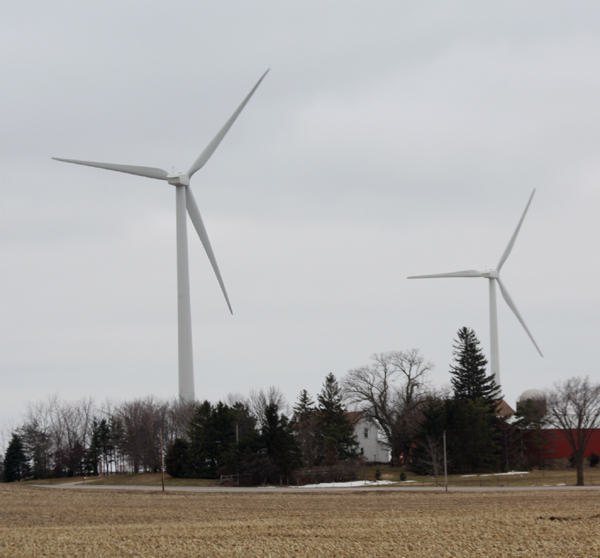
Turbine impact studies conflict
PROPERTY VALUES: Local opponents say wind farms harmful
Opponents of wind farm development in Jefferson County have touted property value decline as a possible harm.
But that argument, or any counterclaim, is getting little support from experts. Two studies on property values around wind farms were released in 2009, but had very different results.
The U.S. Department of Energy's Lawrence Berkeley National Laboratory supported a study that found no measurable value loss linked to wind farms in sales data from 7,459 sales of single-family homes within 10 miles of 24 wind farms in nine states.
Meanwhile, Appraisal Group One, Oshkosh, Wis., conducted a smaller study of vacant land sales in and around two wind farms for the Calumet County Citizens for Responsible Energy this year. In a year where property values suffered nationally, that study found the average loss in value at 40 percent in one wind project's area and 30 percent in the other.The Energy Department study, led by Ben Hoen, looked at home sales from 1996 to 2007. It compared the characteristics of the homes in several models.
"Specifically, neither the view of the wind facilities nor the distance of the home to those facilities is found to have any consistent, measurable and statistically significant effect on home sales prices," the report said.
The number of transactions, which included 125 within a mile after construction and about 60 within 3,000 feet, decreased the margin of error.
"It was more data than had been collected before," Mr. Hoen said. "We tried a lot of different ways of testing the data. It's the most complete analysis of the subject to date."
But Kurt C. Kielisch, president of Appraisal Group One, said the sheer number of sales included in the Energy Department study may have clouded the results.
"You can lose the distinction in numbers," he said. "You only need 20 to 30 good sales for a very good study."
His appraisal firm's study included sales of 12 vacant parcels inside two wind projects' boundaries and 90 vacant parcels outside the boundaries. All of the parcels were within one-half mile of turbines and had a view of them.
"It is logical to conclude that the factors that created the negative influence on vacant land are the same factors that will impact the improved property values," the study said. "Therefore, it is not a leap of logic to conclude that the impact of wind turbines to improved property value would also be negative."
Mr. Hoen said the Energy Department study has its advantage in the high number of sales included.
"In other studies the effect exists based on the surveys of Realtors," he said. "In our study, we concentrated only on actual transactions."
Appraisal Group One did include a survey of real estate agents. Mr. Kielisch argued that the results tracked very closely with his sales data.
"Every appraiser gets opinions from Realtors," Mr. Kielisch said. "They are in the trenches and we are the observers."
The survey asked about property value on parcels within 600 feet, 1,000 feet and one-half mile of the turbines. The agents agreed there would be lost value for all the lots, vacant or improved. How much, between 24 percent and 43 percent, depended on the distance.
Based on his results, Mr. Kielisch suggested that property owners ask for a property value assurance agreement, where a developer would pay the difference between a property's sale price and the value of comparable property outside of a wind power development if the property loses value.
"If you really believe that the value won't decline, guarantee that fact," he said.
Both researchers agreed future studies should include some data on how long properties are on the market. Other areas to consider include whether secondary residences and certain scenic vistas are more sensitive, Mr. Hoen said.
NOTE FROM THE BPWI RESEARCH NERD:
Story Problem: If the DOE report used sales data from 7,459 sales of single-family homes within 10 miles of 24 wind farms in nine states, and 125 of those homes were within a mile of the wind farm after construction and about 60 of those were within 3,000 feet, what percentage of the homes in this study are located within one mile of a wind farm?
ANSWER: 1.67 %
Extra Credit: What percentage of the homes in this study were located within 3000 feet?
ANSWER: 0.8 %
Extra extra credit: What is the setback from a home in Wisconsin?
ANSWER: 1000 feet or less.

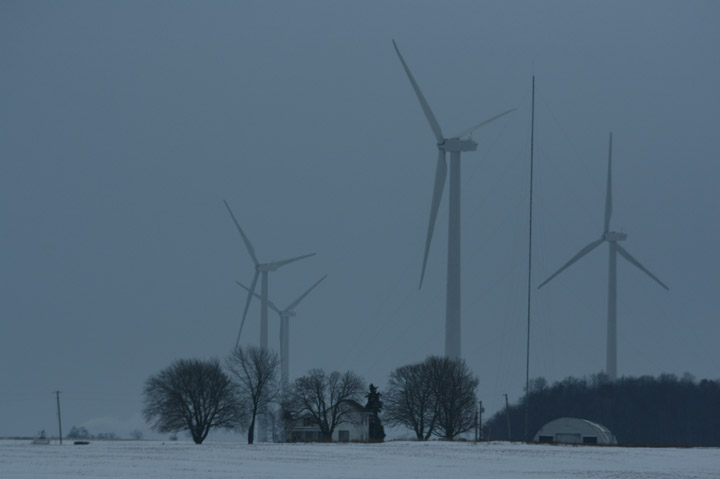
12/23/09 Christmas comes to those who fight to protect their communites
 SANTA VISITS ROCK COUNTY, WISCONSIN:
SANTA VISITS ROCK COUNTY, WISCONSIN:
Company representative confirms EcoEnergy is no longer a part of the EcoMagnolia project
In an email sent yesterday to Better Plan, Wisconsin, EcoEnergy confirmed they are no longer a part of developing a proposed wind farm for the Town of Magnolia. The project has been sold to Spanish wind developer, Acciona which now owns the lease agreements signed by landowners in the Towns of Magnolia and Union. Though the sale of the project took place over a year ago, EcoEnergy had stated they intended to stay with the project. What prompted EcoEnergy's decision to abandon the project is unknown.
Whether Acciona intends to build the wind farm with the land leases it now owns in Rock County, or or sell the leases to another buyer is also unknown.
Better Plan, Wisconsin has contacted Acciona's Chicago office to ask what the future plans are for the EcoMagnolia project but have yet to receive a reply.
The specific duration of the landowner lease/easements to land in Rock County which are now owned by Acciona is unknown. However, according to Windustry, "Wind leases and easements are often written to cover extremely long periods of time—30 to 60 years is common, and they can be longer than 150 years in some cases." [click here to read at source]
The original proposal called for 67 wind turbines, each as tall as a 40 story building, to be sited within the Town of Magnolia's 36 square miles.
The Town of Magnolia was the first Town in Rock County to adopt a large wind ordinance with a setback of 2640 feet from homes. Since then, four other Rock County towns have adopted a similar ordinance with the same setback. They are the Towns of Union, Janesville, Center and Spring Valley. All of the ordinances include a provision which allows a landowner to sign a waiver with the developer and the Town to have turbines closer to their homes if they wish.[Click here to download the Town of Union ordinance]
CLICK HERE TO READ ABOUT TURBINE NOISE AND HEALTH CONCERNS OVER ANOTHER ACCIONA PROJECT
NEXT: SANTA VISITS NEW ULM, MINNESOTA:

Early Christmas for farmers threatened with eminent domain for Minnesota wind power farm
Review Messenger www.reviewmessenger.com
Christmas came early this week for several Minnesota farmers when state regulators unanimously rejected a permit for a controversial wind farm proposed by the City of New Ulm, which had threatened to use eminent domain authority for the first time on record to seize the wind rights over the opponents’ property in order to force through the 8-megawatt project.
“It’s a first. They’ve has never denied a wind permit like this before,” said Jeff Franta, a farmer who helped organize the opposition. ”The city utility commission has the intimidating tool of eminent domain and doesn’t have to take ‘no’ for an answer and they didn’t. We’re not interested. It doesn’t belong out here.”
“This decision sends two important messages in our view,” said Annette Meeks, CEO of the Freedom Foundation of Minnesota. “First, rather than bullying landowners with eminent domain powers, city government utilities must work cooperatively with landowners the same as private developers do. Second, the current rush to install wind farms and other green energy projects does not trump private property rights.”
In a case that has attracted national attention among groups monitoring eminent domain takings, on December 21st the Minnesota Public Utilities Commission (PUC) voted 5-0 to deny the New Ulm Public Utilities Commission application to erect five wind turbines in rural Lafayette Township.
It is the first time the PUC has ever denied a permit for a wind farm project, a ruling that sends a clear signal to developers of “green energy” in Minnesota.
“There’s an expectation for these projects to move ahead with developers to engage the communities to get voluntary participation in these projects and land rights are a significant component in the commission’s assessment of a project’s viability,” said Bob Cupit, an expert with the PUC.
.
New Ulm had acquired easements for 237 acres to erect the turbines, but needed to obtain the wind rights to about 235 acres of adjacent property in the path of the prevailing winds to assure a free flow of wind to the turbines.
While public utilities have fairly broad powers to use government authority to force property owners to sell to meet their needs, experts said the New Ulm plan involved an unprecedented move to expand eminent domain authority to include the seizure of air space on private property for power generation.
In a July 30, 2009 filing with the PUC, Nierengarten, on behalf of the New Ulm Public Utilities Commission, insisted “the development of clean, renewable energy should be the motivating, prudent public policy consideration, not provincial notions of “local control” and the “rural way of life.”” If not, Nierengarten added, “it will be necessary for the City of New Ulm to exercise its powers of eminent domain to secure such rights and move this vital project forward.”
The opponents say they do not object to wind power per se, but have concerns about noise levels, lower property values, and the project’s adverse impact on the landscape and rural atmosphere.
“I think developers are going to pay attention to this and we’re not going to move too quickly with projects until a higher percentage of the land rights are acquired before they engage the formal proceedings for a permit,” said Cupit of the PUC .
Despite the ruling, neither side appears to consider the matter completely settled. New Ulm officials indicated they may continue to pursue the project. Opponents are already working with local legislators on draft legislation that would prevent other landowners from facing the same threat in the future.
“A public utility such as New Ulm cannot have that threat of eminent domain from the start,” said Franta. “Landowners should know from the start that they don’t have to be worried about losing their land unwillingly. Who wants to do business with someone who forces something onto you?”
The case comes at a critical time with Minnesota and the nation fast tracking green energy projects that are often fueled by federal grants, including billions in stimulus spending. Minnesota ranks fourth in overall wind production nationally with 1805 megawatts of wind-generated electrical capacity. Currently, approximately 21 wind energy projects and proposals are on the table statewide, according to the PUC.
A WARM, BRIGHT, HOPEFUL AND MERRY CHRISTMAS TO ALL FROM BETTER PLAN, WISCONSIN
12/23/09 Learning the hard way about trust, wind industry siting standards and turbine noise.
Hard lessons from the Fox Islands Wind Project
Amongst the participants were many of us who are neighbors of the turbines. Although our group overwhelmingly supported the project, we now live with the daily presence of turbine noise, 24/7.
As one of the Fox Islands Wind Neighbors (FIWN) recently noted, "We support the windmills, but not the noise." The noise is as constant as the wind, building in intensity according to wind speed and direction.
It can be a low rumbling, whooshing, grinding background noise that one can just hear above the sound of the trees or it can build to an in-your-face noise, like jet engines roaring combined with a grinding and pulsating sound that echoes in your head, keeps you awake at night, and beats on your house like a drum.
As neighbors of the wind turbines, we find ourselves in the midst of an unexpected, unwanted life crisis. When GE flipped the switch and the turbines began to turn, island life as we knew it evaporated.
As I watched the first rotation of the giant blades from our deck, my sense of wonder was replaced by disbelief and utter shock as the turbine noise revved up and up, past the sound of our babbling brook, to levels unimagined.
It was not supposed to be this way!
During informational meetings, on the Fox Islands Wind website, in private conversations, and with personal correspondence, we were all told that ambient noise from the surrounding area would cover the sound of the turbines. This was our expectation. The Fox Islands Wind August 31 cover letter to the state Department of Environmental Protection (DEP) explained, "When the turbines are generating higher sound levels, background noise will be higher as well, masking the sound of the turbines."
On the Fox Islands Wind Web site FAQ we read, "The blades passing through the air can make a ‘whooshing' sound and mechanical parts or unusual wind currents can produce a steady ‘hum' or ‘whine.' However, ambient noise is usually louder than any noise produced by wind turbines and modern wind turbines are significantly quieter than older models."
Our immediate experience was the reverse.
Since that moment of realization, we have been on a steep learning curve. Our days are filled with e-mail correspondence with neighbors and George Baker, of Fox Islands Wind, research on the noise pollution and health risks associated with turbine noise, research on the impact of low-frequency noise, research on technological solutions, research on the impact of turbine noise on domestic and wild animals, research on state sound regulations, conversations with the press, neighborhood meetings, meetings with the electric cooperative and FIW, a meeting with the DEP, multiple letters to our State Representative, Hannah Pingree, letters to Congresswoman Chellie Pingree, letters to the Vinalhaven Land Trust board members, e-mails to possible sound consultants, debates with neighbors as to how we will pay for a sound consultant, letters to the DEP where we are beginning to know everyone's name, and the list goes on.
We have been to the town office to copy tax maps and get the addresses of year-round and summer residents who live near the turbines. We have driven all over the island with sound meters, determining that the turbine sound can travel more than a mile in certain areas and noticing whose homes are impacted.
We have spoken with people in town to spread the word. We have invited people to our homes to listen for themselves. We have learned and explained under which conditions the turbines are loudest and why. We have developed data sheets so we can keep daily noise observation records. We have worked to find the words and sounds to describe the noise, each perfecting our own imitation, some better than others.
We have learned to count windmill rpm and discovered that above 15 rpm the noise is tough to take. We have read lengthy amendments and studied sound protocols.
We have learned about state sound regulations and found that the 45 decibel limit that is designated as "quiet" in Maine, is truly a cruel joke. On our quiet cove, we now know that 45 decibels is loud.
We have studied spreadsheets, yearly wind speed records, and have worked to determine how much Fox Islands Wind can slow the turbines down and still cover the cost of the windmills. We are scrambling.
We do not want to leave the homes we have built with our own hands, the gardens we have planted, the memories that are so much a part us, and the dreams we hold for the future. We are not looking for financial gain. We are desperate to gain back what has been taken from us.
From where we are sitting, it seems that the industry standard for turbine noise in rural areas is absolutely wrong! I cannot speak for all the Fox Islands Wind Neighbors on this, but my husband and I feel that, on a local level, well-meaning individuals made a critical miscalculation.
Depending on wind speed, wind direction, etc., we estimate that households within a mile to a mile-and-a-half radius of the turbines are impacted by the sound.
This is a very serious issue that affects many homeowners on Vinalhaven and could also, due to diminishing property values, affect the tax base of the town. In an island community, such as Vinalhaven, where people sincerely care about and support one another, we are in the position where economic gain in the form of reduced electrical rates/wind turbine debt could be pitted against community well-being.
How willing will the Fox Islands Wind Cooperative and the community be to share the burden of this major miscalculation? Rather than bringing us together, the noise from the turbines has the potential to tear our community apart.
As I type, a computer is whirring away in our basement, sending wind speed data and noise level data to sound technicians in Boston. FIW is taking sound measurements, as required by the DEP, and it is our joint hope that they will be able to make adjustments to windmills in order to reduce the noise.
Along with our neighbors, we are recording daily noise observations which sound specialists can use as a means to determine under which conditions the noise is most disturbing. We are eager participants in doing whatever we can to rectify the situation. We feel fortunate that Fox Islands Wind is controlled by the Fox Islands Electric Cooperative and that they are eager to work with us to find an answer.
However, it is very clear to us, that life as we know it on Vinalhaven has changed irrevocably.
We understand that our best hope is to come to a reasonable compromise. We are working with FIW to find a balance between the level of noise that is tolerable and the turbine speed necessary to produce electricity.
This is a far cry from what we were told and what we expected. One has to wonder if wind turbine technology is truly ready to be implemented in rural areas. Community based wind power is a very good idea, a smart answer to our energy dilemma. The numbers actually work. It is just that our life-for us, and for our neighbors-does not.
Ironically, for households within earshot of the turbines, the GE windmills fly in the face of island sustainability. Some islanders who lived close to the turbines were given the choice of either selling their homes or land to FIW at the assessed value or living with the turbine noise.
Most chose to sell rather than live with the noise.
Others are trying to stay where they are with hopes that GE specialists and FIW sound specialists will find technological solutions.
The Island Institute website states, "The Institute's perspective is fundamentally ecological. It understands that all life is intimately linked with its environment; that people are therefore an inextricable part of the ecosystem of the Gulf of Maine, that there is an interdependent web of existence more evident on islands than in other communities and landscapes."
As is, there are some year-round families on Vinalhaven who feel their existence is being marginalized and the noise issue minimized.
Before any other island community takes the step towards wind power, come to Vinalhaven and see for yourselves the consequences of those actions. Come to our meetings.
Come stand on our porches, listen to the nonstop roaring, thumping, whooshing, grinding sounds of the turbines, and compare it to the quiet you currently experience. Watch how our community struggles with this issue and see how we resolve it.
Look at the compromises we make and decide if those trade-offs are worth it for you and your neighbors. For many islanders, a cohesive, caring community and good quality of life are of critical importance. Don't let the wind blow it away.